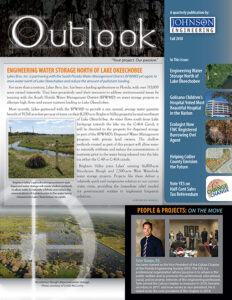 For more than a century, Lykes Bros. Inc. has been a leading agribusiness in Florida, with over 337,000 acres owned statewide. They have proactively used their resources to address environmental issues by teaming with the South Florida Water Management District (SFWMD) on water storage projects to alleviate high flows and excess nutrient loading to Lake Okeechobee.
For more than a century, Lykes Bros. Inc. has been a leading agribusiness in Florida, with over 337,000 acres owned statewide. They have proactively used their resources to address environmental issues by teaming with the South Florida Water Management District (SFWMD) on water storage projects to alleviate high flows and excess nutrient loading to Lake Okeechobee.
Most recently, Lykes partnered with the SFWMD to provide a net, annual, average water quantity benefit of 39,765 acre-feet per year of water on their 8,200-acre Brighton Valley property located northwest of Lake Okeechobee. As water flows south from Lake Istokpoga towards the lake via the C-41A Canal, it will be diverted to the property for dispersed storage as part of the SFWMD’s Dispersed Water Management program with private land owners. The shallow wetlands created as part of this project will allow water to naturally infiltrate and reduce the concentrations of nutrients prior to the water being released into the lake via either the C-40 or C-41A canals.
Brighton Valley joins Lykes’ existing 16,000-acre Nicodemus Slough and 2,500-acre West Waterhole water storage projects. Projects like these deliver a relatively quick and inexpensive solution to our current water crisis, providing the immediate relief needed for governmental entities to implement long-term solutions.
Johnson Engineering has worked with Lykes for decades on various projects and was eager to help make the Brighton Valley project a reality. Our wide variety of in-house services helped expedite the project design and permitting through the simultaneous coordination of surveying and mapping, GIS, electrical, and surface water management engineering services.
The initial survey task laid the groundwork for the rest of the team to model, design, and permit the project, which straddles a watershed divide. Our survey field crews established the boundary line, located right-of-way monumentation, and established a closed level loop around the project for vertical control used during the topographic survey, a total of approximately 15 miles of bench line. Ground elevations were collected to determine alignment and height of berms to be constructed. Additional topographic data and cross-sections were measured in areas of critical concern, including intake pump locations and canal discharge locations.
The elevation data generated by the survey was critical to the design of the project. Since the land is a mixture of upland and wetland land cover, it enabled our surface water engineers to properly size levees, control structures, and an internal pond to place pumps to lift the water flowing from the C-41A Canal to the storage cells. A new electric utility service had to be designed to provide power to the pump station bringing water from the C-41A Canal. The pump station, also designed by Johnson Engineering, is comprised of six 200 horse power pumps. Our team assisted with the engineering component of the Environmental Resource Permit (ERP) and the Right-of-Way Occupancy Permit from the SFWMD. We also assisted the environmental consultant in obtaining approval through the United States Army Corps of Engineers.
The original conceptual design anticipated Brighton Valley would entail a simple impoundment similar to that used at the Nicodemus Slough project to its south. However, various challenges prompted design modifications to route flows on the site, detain water in the system, and strategically release it as needed. Our design team designed a management system to meet the inflow and outflow rates requested by the SFWMD, while minimizing construction costs with features consistent with the original agricultural impoundment-style vision. Developing a robust operational plan for the project, in coordination with Lykes, allowed us to fine tune the components of the system, without adding more complexity to the modeling and design approach.
The operational control strategy developed by our team considered the levels in the canals and impoundment areas as well as pump sequencing scenarios. Given the watershed divide and regulatory limitations on canal stages, this task included estimating water levels necessary for operating the project under different scenarios and creating the framework for operational coordination between Lykes and the SFWMD. These considerations make Brighton Valley one of the most complex dispersed water storage projects to-date and highlight the potential of the program to more adaptively address water supply and storage challenges through use of private lands.
Breaking ground this October, this project will help to improve water quality by reducing the phosphorus and nitrogen loads, and reduce the need for harmful freshwater discharges to coastal estuaries. Johnson Engineering is proud to provide our knowledge and expertise on such an important project, which will have a positive impact on the ecosystem downstream. This project is one piece of the puzzle that will help bring us a step closer in improving the quality of life for our south Florida coastal communities’ residents and visitors.
For more information, contact Andy Tilton, P.E. at [email protected].































































